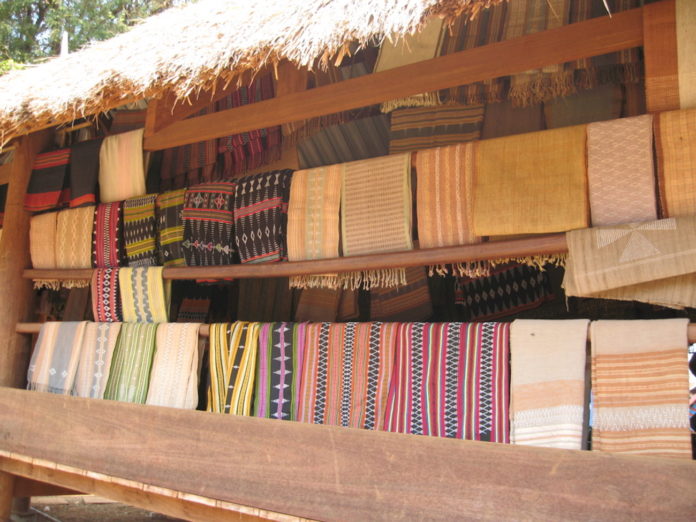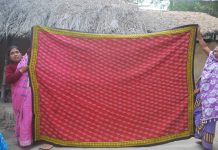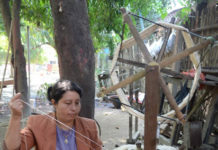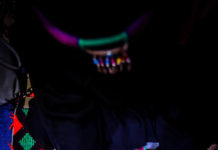Many groups composing the population of the Lao People’s Democratic Republic, commonly known as Laos, practice weaving. Women are the primary producers of textiles and have carried out production for household consumption for centuries. Presently, a few men have become commercial weavers since handwoven textile production is expanding to meet the demand of a growing local market. Government bureaucrats, private business employees, and persons attending are all expected to wear handwoven cloth, especially women who don a tubular skirt (Lao and related languages: sinh), when attending a special event or ceremony.
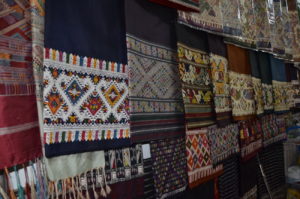 Different types of looms are utilised in Laos. Weavers from the Lao and related groups, such as the Phuthai, Tai Daeng, Tai Dam, Tai Lue, and Tai Phuan, work on a frame loom. Women of other groups, including the Kim Mun or Lanten, weave on frame looms, but they produce unpatterned fabric. In North Laos some subgroups of the Hmong and Khmu produce cloth using body tension looms while others do not weave. Textile producers in South Laos weave on foot-braced versions of the backstrap loom. The Katu, Krieng, and Talieng are a few of these groups.
Different types of looms are utilised in Laos. Weavers from the Lao and related groups, such as the Phuthai, Tai Daeng, Tai Dam, Tai Lue, and Tai Phuan, work on a frame loom. Women of other groups, including the Kim Mun or Lanten, weave on frame looms, but they produce unpatterned fabric. In North Laos some subgroups of the Hmong and Khmu produce cloth using body tension looms while others do not weave. Textile producers in South Laos weave on foot-braced versions of the backstrap loom. The Katu, Krieng, and Talieng are a few of these groups.
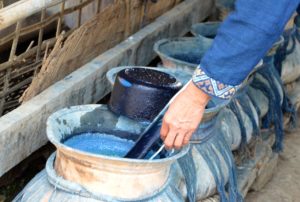 For frame loom weaving, the use of continuous supplementary weft (Lao and related languages: khit), discontinuous supplementary weft (Lao: chok; Tai: ko), supplementary warp (Lao and related languages: muk), and twill (Lao and related languages: sii khao) techniques is found throughout the country. Some weavers in North Laos, such as the Tai Lue and Tai Daeng, apply dovetail tapestry (Lao and related languages: ko luang). Both warp and weft ikat (Lao and related languages: mat mii) techniques are also utilised, but the warp ikat designs are not complex, often consisting of small dashes. By threading beads onto the weft thread, Katu weavers form patterns with the beads by strategically placing them between warp threads.
For frame loom weaving, the use of continuous supplementary weft (Lao and related languages: khit), discontinuous supplementary weft (Lao: chok; Tai: ko), supplementary warp (Lao and related languages: muk), and twill (Lao and related languages: sii khao) techniques is found throughout the country. Some weavers in North Laos, such as the Tai Lue and Tai Daeng, apply dovetail tapestry (Lao and related languages: ko luang). Both warp and weft ikat (Lao and related languages: mat mii) techniques are also utilised, but the warp ikat designs are not complex, often consisting of small dashes. By threading beads onto the weft thread, Katu weavers form patterns with the beads by strategically placing them between warp threads.
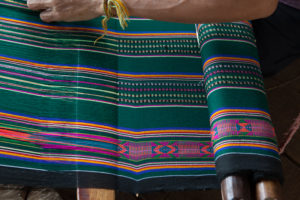 In the past, cotton and silk were the primary materials. Cotton and some natural dyestuffs, such as indigo, were cultivated in small quantities. Some weavers also raised silkworms. The Hmong was the only group to grow hemp. Presently, synthetic materials, including, rayon, polyester, and chemical dyes, are available in the local markets. Weavers use a wide range of natural and synthetic materials, depending on what the market demands.
In the past, cotton and silk were the primary materials. Cotton and some natural dyestuffs, such as indigo, were cultivated in small quantities. Some weavers also raised silkworms. The Hmong was the only group to grow hemp. Presently, synthetic materials, including, rayon, polyester, and chemical dyes, are available in the local markets. Weavers use a wide range of natural and synthetic materials, depending on what the market demands.
 Private companies and village cooperatives involved in weaving are active in Laos. The Katu village of Houay Houn Tai of Salavan Province produces naturally dyed, cotton textiles with beaded patterns. In Samtai District of Hua Phan Province in Northeast Laos, a local woman, Mrs. Sukkhasone, uses natural dyes to colour the silk threads that are given to weavers who work from home to produce the patterns she provides. Private businesses in the nation’s capital of Vientiane centralise dyeing and weaving under one roof. Phaeng Mai and its affiliated business Khang are the sole source for handwoven organza in Laos. Houey Hong Centre is a non-profit business that teaches women vocational skills related to natural dyeing, sewing, and weaving. It provides opportunities to those unable to learn in the village setting.
Private companies and village cooperatives involved in weaving are active in Laos. The Katu village of Houay Houn Tai of Salavan Province produces naturally dyed, cotton textiles with beaded patterns. In Samtai District of Hua Phan Province in Northeast Laos, a local woman, Mrs. Sukkhasone, uses natural dyes to colour the silk threads that are given to weavers who work from home to produce the patterns she provides. Private businesses in the nation’s capital of Vientiane centralise dyeing and weaving under one roof. Phaeng Mai and its affiliated business Khang are the sole source for handwoven organza in Laos. Houey Hong Centre is a non-profit business that teaches women vocational skills related to natural dyeing, sewing, and weaving. It provides opportunities to those unable to learn in the village setting.


